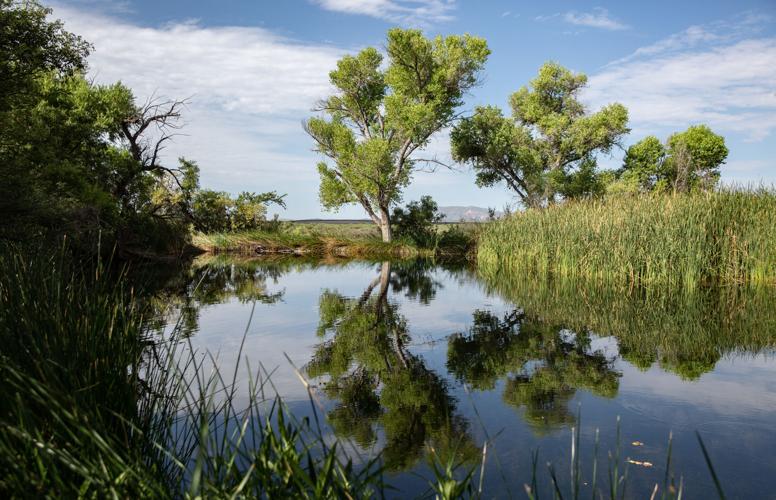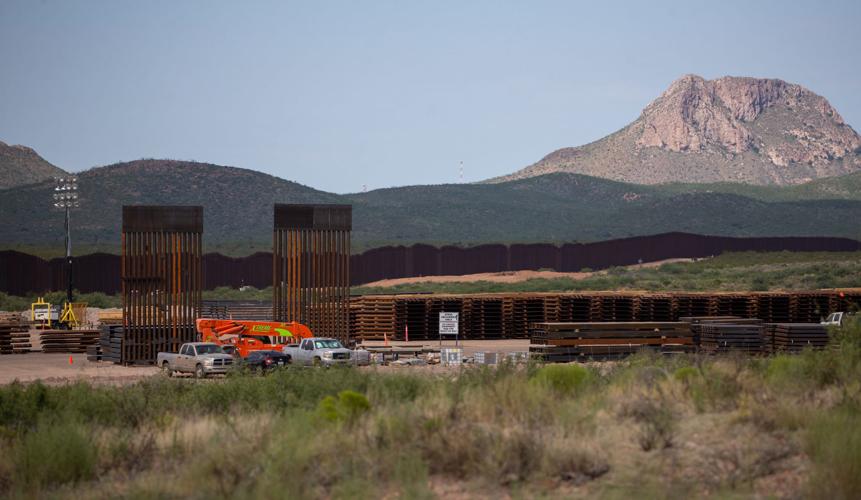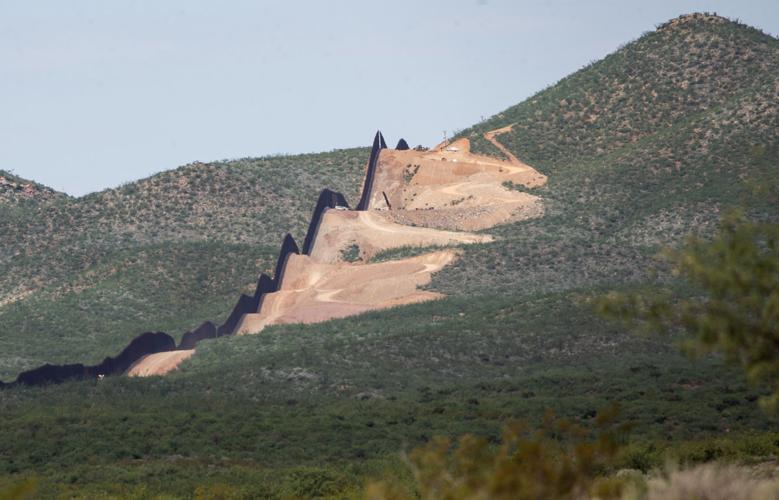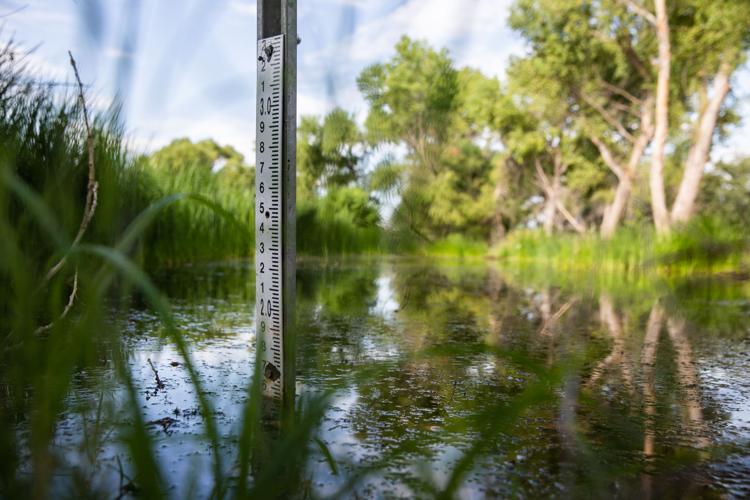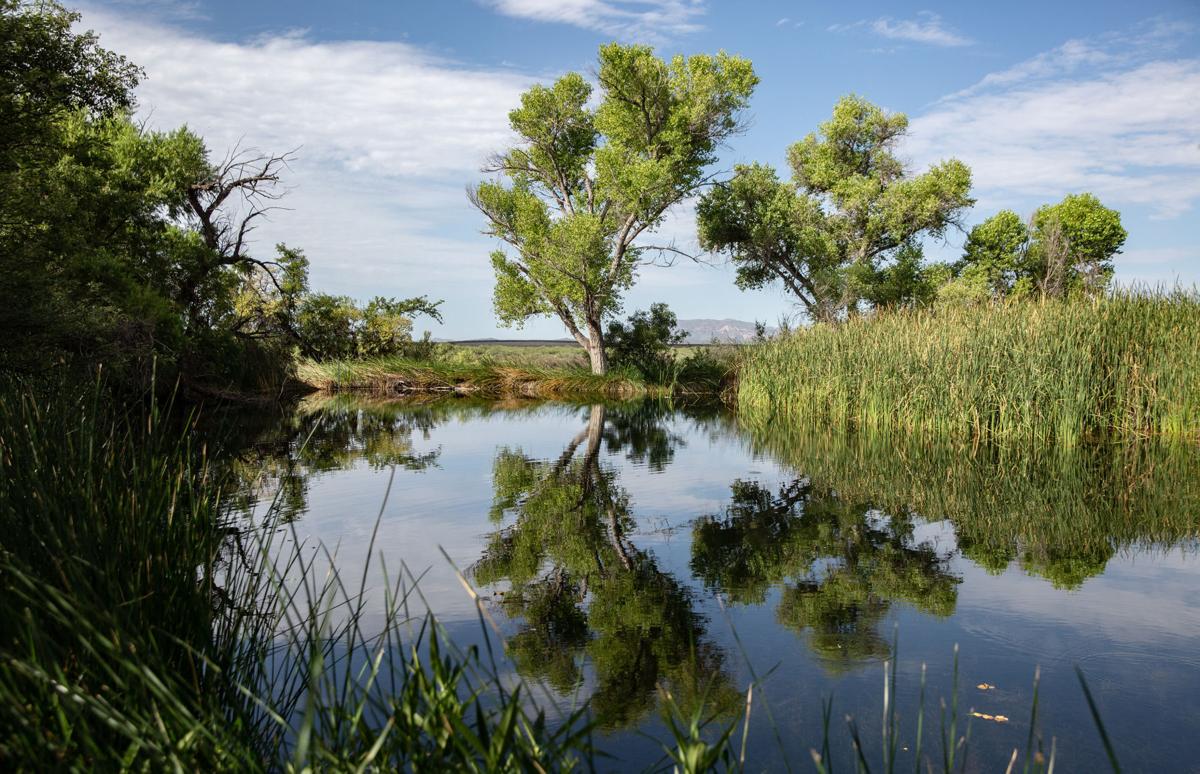Border wall contractors caused a “dire emergency” at a wildlife refuge in Cochise County by pumping millions of gallons of water from an aquifer, staff at the refuge said in recently released emails.
Alarm bells went off with U.S. Fish and Wildlife officials at the San Bernardino National Wildlife Refuge last fall when contractors started building a 30-foot-tall border wall near the refuge, which offers a fragile home to several endangered species in ponds, riparian areas and lush vegetation amid a vast expanse of desert scrub. A year later, their concerns proved prescient, and the contractor is now buying larger water pumps to sustain the refuge.
The area near the 2,369-acre refuge, located about 10 miles from the New Mexico state line, has seen some of the busiest wall construction in Southern Arizona. The new wall project has replaced head-high vehicle barriers, installed around 2008, along some 15 miles of border near the refuge, including 3 miles along the refuge’s southern edge. The $408 million project eventually will include about 20 miles of border wall.
The lush green inside the refuge is a sharp contrast with the arid land that surrounds it. On Friday morning, frogs quickly splashed into ponds on the refuge when a reporter and photographer approached, while a mother turkey hustled her brood into the tall grasses. Songbirds chirped in trees alongside a stream that flowed among large patches of rock and dirt. A solar-powered water pump quietly fed one of the ponds where endangered fish species live. Behind the greenery, the 30-foot wall juts up on the refuge’s border with Mexico.
The tranquility of the refuge was broken last summer when the wall contractor set up an industrial complex about 1.5 miles west of the refuge. The sounds of heavy machinery run by Southwest Valley Constructors, a New Mexico-based affiliate of construction giant Kiewit, now fill the valley, and large trucks barrel up and down the dirt road that runs a few hundred yards north of the border.
The main concern of Fish and Wildlife officials is the water pumped nearly every day for the past year from a well on the complex, which is used to mix concrete for the wall’s foundation and tamp down dust during construction.
Refuge staff warned the Department of Homeland Security the well was too close to the refuge as they scrambled to figure out how much water would be pumped from the aquifer and shut down ponds to conserve water for endangered species, according to emails obtained by the Star under the Freedom of Information Act.
Mostly, refuge staff watched with exasperation as water pressure dropped in wells on the refuge, according to emails sent between August and January.

A construction site for the border wall going up along the U.S.-Mexico border east of Douglas, approximately 10 miles from the New Mexico state border.
“Damage is permanent”
“The threat of groundwater depletion at San Bernardino NWR has gone from ‘concerning’ to ‘dire emergency,’ ” refuge manager Bill Radke wrote in an October email.
By November, Radke said water monitoring on the refuge was “already showing harm to our aquifer during months when the refuge has always demonstrated an increase in groundwater levels.
“We have ponds dropping precipitously (as much as a foot already) that have never gone low during the winter months — not ever,” Radke wrote.
Customs and Border Protection and the Army Corps of Engineers did not respond to an inquiry from the Star about the impact of wall construction on the refuge.
A June 10 analysis by a Fish and Wildlife official showed more than 31 million gallons of water were pumped from the well near the refuge from November to May, according to a document obtained by Defenders of Wildlife, an environmental advocacy group. That is enough to cover 95 acres of land with one foot of water.
“That’s nothing if you live on the shore of Lake Michigan, but in Southern Arizona that’s an incredible amount of water,” said Randy Serraglio, Southwest conservation advocate at the Tucson-based Center for Biological Diversity, which has filed lawsuits opposing the border wall.
The water under the refuge is “fossil water” that is at least 6,000 years old, Serraglio said. When large amounts of water are pumped from the aquifer, the “damage is permanent.”
A drop in water pressure at wells on the refuge correlated with pumping for wall construction, according to a statement last week from the public affairs office for Fish and Wildlife. The refuge now needs larger-capacity pumps to “maintain pond levels and appropriate pond outflows,” which the wall contractor is buying and installing.
In the meantime, “refuge ponds remain intact, and the refuge continues to manage for endangered fish and wildlife,” according to the statement.

Turkeys can be found among the wildlife on the San Bernardino National Wildlife Refuge. Here, a mother turkey leads her brood into the tall grasses near Twin Pond.
“Disappointing is an understatement”
The Slaughter Ranch Museum is adjacent to the refuge and contains an idyllic pond fed by an artesian spring. In the scramble to deal with the wall contractor pumping water from the aquifer, the foundation that runs the museum installed a pump to ensure the pond wouldn’t go dry and to protect an endangered snail species that only lives on the museum’s land, the Fish and Wildlife emails show.
Environmental advocates warned of the danger to the refuge as soon as the wall project was announced in May 2019, particularly when DHS officials waived numerous laws to speed up construction, including requirements to do environmental assessments.
Radke had warned DHS officials in June about the risk to the refuge and asked why the wall was necessary when Border Patrol agents had arrested only a handful of migrants crossing the border illegally on the refuge the previous year.
The federal approach to building the border wall along Arizona’s border with Mexico is “completely careless,” Serraglio said.
The San Bernardino refuge was not the only place environmental advocates warned could be damaged by wall contractors pumping water. The pond at Quitobaquito Springs, an ancient watering hole next to the border about 150 miles southwest of Tucson, is drying up. Southwest Valley Constructors pumps water from the aquifer that feeds the springs, but experts say the cause of the pond drying up is complicated and could involve agricultural water use and a decades-long decline in the aquifer.
DHS officials do not take seriously the input of local landowners, land managers and others “who know the landscape,” Serraglio said.
“Those voices are silenced, and it creates all kinds of problems,” Serraglio said.

A measurement of the Tule Pond on the San Bernardino National Wildlife Refuge located east of Douglas, on Aug. 14, 2020.
Radke wrote in October he was “disappointed” to see DHS and the Army Corps of Engineers did not abide by a request to minimize water withdrawal from the aquifer that supports the refuge’s wetlands. In response, Joaquin Baca, another refuge staff member, wrote: “disappointing is an understatement.”
Radke wrote in November he did not know what reaction to expect from DHS or the Corps, “but so far our requests have been consistently met with indifference.
“We have already turned water off to three refuge ponds in an effort to minimize the impacts to other ponds, and have salvaged and relocated endangered fish (kind of like cutting off individual fingers in an attempt to save the hand),” Radke wrote in November.
Officials with the Fish and Wildlife district that covers Texas, Oklahoma, New Mexico and Arizona considered the ongoing water withdrawal adjacent to San Bernardino National Wildlife Refuge as the “current greatest threat to endangered species in the southwest region,” Radke wrote in December.
Collateral damage
The owner of the main well used by the wall contractor also said her concerns about the wall project fell on deaf ears.
“I spent days and months fighting this project, and there is a point that no matter what you say, the government is going to press forward whether it is the best thing to do or not,” said Kelly Glenn-Kimbro.
Her family owns the Glenn Ranch that surrounds the refuge on three sides. She called the water situation on the refuge “horrifically stressful and heart wrenching.”
The Glenn-Kimbro family has cooperated with CBP in many ways since the family bought the ranch in the 1960s, she said, including by allowing CBP to set up two surveillance towers on their land. At the same time, her family also is “conservation minded,” she said.
“Through the years, we have protected the refuge, strategized with the refuge for the good of the landscape,” she said.
Her family “strongly opposed” building the wall to replace the vehicle barrier built in 2008, which was “serving the area well.” The level of cross-border illegal activity in the valley was “not high enough to warrant a wall of this nature,” she said.
Border Patrol officials generally do not share local statistics on illegal cross-border activity with the news media, but it is not uncommon for them to update landowners and officials on activity in their area.
The Glenn Ranch well was drilled in 2008 to build the vehicle barrier, Glenn-Kimbro said. The well was signed over to her family when the project was complete. It was the “only compensation” they received for allowing a construction complex on their land for nearly two years.
When her family decided to let the contractor for the new wall use the same well, “our thought was to continue to protect the refuge by keeping the water use away from the refuge,” Glenn-Kimbro said.
She worried the contractor might drill another well “possibly within feet of our well” if her family refused. Even worse, the federal government might “commandeer refuge wells for the project.”
“It is easy to point fingers” and blame her family for the refuge’s water problems, “but the rancher and the refuge itself are collateral damage,” she said, noting several lawsuits to stop the wall have failed.
“What people do not get is the hardcore truth,” she said. “This project is here, it is mandated, it is going to be completed with no consideration by the government as to the huge devastating negative impacts that are felt by the people, the landscape, the resources, the wildlife, the communities — whether ranching, farming or municipal — and the people who have dedicated their life to preserving threatened and endangered species and a segment of the landscape.”
Some of the water used for the wall project comes from the City of Douglas, about a dozen miles west of the refuge. The city planned to provide 30,000 gallons of water daily for the wall project, but the contractor decided not to build a concrete batch plant in the city, according to Luis Pedroza, management services director for the City of Douglas.
The city still provides about 21,000 gallons of water daily to the contractor, which has not caused any problems with the city’s water supply.

Desert area was cleared to build a section of the border wall east of Douglas, near the New Mexico state line.


